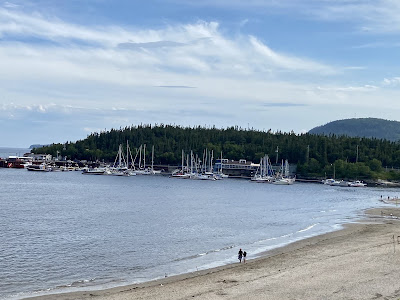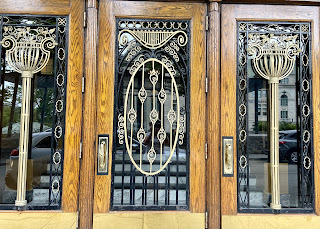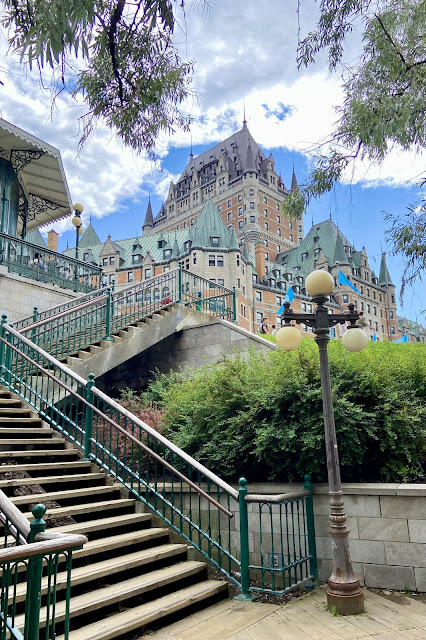Rick speaking-Melanie is still in bed…
The tide wants what it wants (I'm sure someone famous said that once) -- so to take advantage of the outgoing (ebb) tide, we were once again up at the crack of dawn (but only 6 am this morning) and heading out onto the St. Lawrence river. Our destination, Tadoussac and the Saguenay river, is the furthest east we will go on the boat (this year anyway).
Below is a screen shot of the tide table graph showing the tidal variation at Tadoussac. About every six hours the tide goes up or down by between 12 and 14 feet. You can imagine the amount of water that is rushing in/out of the area and how important it is to time your travel so you go with the tide and not against it. I was anxious about this aspect of our trip, but with some study and help from locals I feel more confident that I have come to understand how the tides work and how they can be used to our advantage.
The river was calm and smooth as we cruised into another rising sun, while listening to our local Atlanta NPR station streaming on my cellphone - even out here at the end of the world. Since we get all of our navigation and weather information from the internet I was a bit concerned about cellphone coverage (I even had purchased a back up Canada sim card with a local data card, just in case). Fortunately the coverage has been strong, with no problems receiving weather information or streaming important things like Guy Fieri on The Food Network (it's not officially a Friday unless we have Guy).
As we moved further out the river we felt a pretty dramatic decrease in the air temperature. The water temperature has dropped 20 or more degrees and the air reflects that drop. It is cold! We had to put on our long pants and sweaters - We are so happy!
 |
| This quaint lighthouse installation caught our fancy. It seemed just perfect, dramatically set as it is against the mountains! |
As we have mentioned, this area is well known for whales and the ride to Tadoussac didn’t disappoint. Soon we were seeing pods of Belugas with young and the rising backs of feeding Minke whales. Due to the Marine Park regulations we are not allowed to get within 400 meters of the Belugas, as they are endangered. Additionally you are not allowed to slow/stop or follow them. Boaters are supposed to continue travel at between 5 - 10 mph and put distance between the boat and the whales. So we can’t get too close, but it is still amazing to see 20 or 30 whales bobbing along in the distance. (Mel here - also, that is an impossible set of rules because you can never tell where the whales will pop up. AND the three endangered species, Belugas, Blue and Right, require more distance then others, etc - which assumes you can a) ID them the second you see them, b) remember all the different rules c) drive the boat while magically doing the first 2, and fighting every instinct in your body to go pet one).
 |
| Each little white spot a Beluga - they are very social and travel in pods. They are the chattiest of all whale species, apparently that is what that big head bubble, the melon, is for. |
 |
| You can see the young Beluga, grayish in color, riding along next to Mom |
 | ||
| Belugas no not have a dorsal fin, so mostly they look like white lumps. They also rarely lift their tail out of the water (Minke's are the same), but here in the distance you can see a bit of tail. |
There were many sailboats on the water moving slowly along. The wind was almost non-existent so we think they were just watching the whales with the sails up to make it look like they were following the rules. There are many marine and park police around to make sure no one molests or bothers the whales. All the literature says that Belugas need space and tranquility - Mel is wondering how they polled the whales on this...
 |
| You know Mel is a sucker for a good reflection! |
 |
| This seal took a good long look at us as we passed by. They have such a dog-like look. |
Tadoussac came into view just at the mouth of the Saguenay River, but we continued on for 30 minutes in to deeper water (500 ft) in the hopes we might see the really big whales. Further downbound the water will get 700-1000 ft, but fog was coming in and we wanted to get on the dock.
We made our way to the marina using our best French to call in and ask for help with our docking. It is amazing how many words we have been able to learn and how we’ve been able to make due with our limited language. After docking we went up to the marina office to check in and found that the clerk at the desk really spoke almost no English. Nonetheless with our French, Spanish and hand gestures were were able understand each other and even make a reservation for our return stay next week.
Oddly enough we had expected Tadoussac to be a small, sleepy town with almost nobody around. How wrong we were. The town is indeed small, but has a summer resort vibe and is inundated with tourists here for the whale watching. Right by our dock at the marina is the commercial dock and there is nearly constant traffic of small and large whale watching boats coming in and out loaded with hundreds of people. As we walked around the town in the afternoon we encountered full restaurants and parking lots, and people everywhere.
 |
| A view of the marina from town - there is a little plage (beach) that extends almost to the marina at low tide. |
 |
| Summer visitors, mostly from the US, pooled their funds and built this Protestant Church in the 1850’s |
 |
| The oldest wooden chapel in North America - opened in 1754 by Jesuit Priests |
 |
| Look how nicely she is posing for her close-up. It even looks like she has crossed her legs in a super model-like way! |
There are whales all over the place. Later in the day we walked out on a point overlooking the river. We had a great show put on by a number of Minke whales as they fed on whatever was in the water. Minke are filter feeders and the whales repeatedly came out of the water with their mouths in the air squirting water out so they could eat whatever was trapped in their baleen.
 |
| The sun setting slowly over the Saguenay River. |
 |
| With the pine trees and granite it feels kind of like the Pacific Northwest. |







































